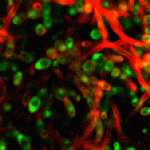Lien vers Pubmed [PMID] – 25502890
Lien DOI – 10.1371/journal.ppat.1004542
PLoS Pathog 2014 Dec; 10(12): e1004542
Biofilm formation is an important virulence trait of the pathogenic yeast Candida albicans. We have combined gene overexpression, strain barcoding and microarray profiling to screen a library of 531 C. albicans conditional overexpression strains (∼10% of the genome) for genes affecting biofilm development in mixed-population experiments. The overexpression of 16 genes increased strain occupancy within a multi-strain biofilm, whereas overexpression of 4 genes decreased it. The set of 16 genes was significantly enriched for those encoding predicted glycosylphosphatidylinositol (GPI)-modified proteins, namely Ihd1/Pga36, Phr2, Pga15, Pga19, Pga22, Pga32, Pga37, Pga42 and Pga59; eight of which have been classified as pathogen-specific. Validation experiments using either individually- or competitively-grown overexpression strains revealed that the contribution of these genes to biofilm formation was variable and stage-specific. Deeper functional analysis of PGA59 and PGA22 at a single-cell resolution using atomic force microscopy showed that overexpression of either gene increased C. albicans ability to adhere to an abiotic substrate. However, unlike PGA59, PGA22 overexpression led to cell cluster formation that resulted in increased sensitivity to shear forces and decreased ability to form a single-strain biofilm. Within the multi-strain environment provided by the PGA22-non overexpressing cells, PGA22-overexpressing cells were protected from shear forces and fitter for biofilm development. Ultrastructural analysis, genome-wide transcript profiling and phenotypic analyses in a heterologous context suggested that PGA22 affects cell adherence through alteration of cell wall structure and/or function. Taken together, our findings reveal that several novel predicted GPI-modified proteins contribute to the cooperative behaviour between biofilm cells and are important participants during C. albicans biofilm formation. Moreover, they illustrate the power of using signature tagging in conjunction with gene overexpression for the identification of novel genes involved in processes pertaining to C. albicans virulence.




